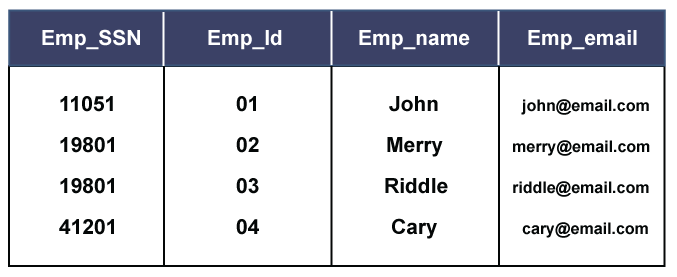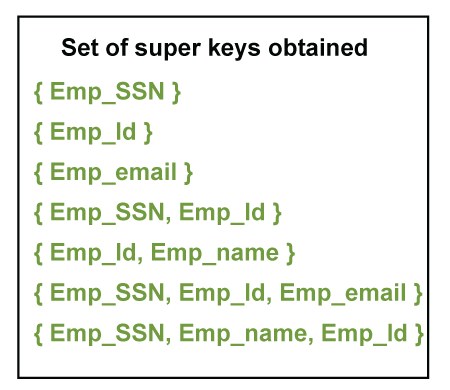-
DBMS Tutorial
- dbms-tutorial
- what-is-database
- types-of-databases
- what-is-rdbms
- dbms-vs-rdbms
- dbms-vs-file-system
- dbms-architecture
- three-schema-architecture
- data-models
- data-model-schema
- data-independence
- dbms-language
- acid-properties-in-dbms
Data modeling
- er-model-concept
- notation-for-er-diagram
- er-design-issues
- mapping-constraints
- dbms-keys
- dbms-generalization
- dbms-specialization
- dbms-aggregation
- convert-er-into-table
- relationship-of-higher-degree
Relational data Model
- relational-model-concept
- relational-algebra
- join-operation
- integrity-constraints
- relational-calculus
Normalization
- functional-dependency
- inference-rule
- dbms-normalization
- dbms-1nf
- dbms-2nf
- dbms-3nf
- dbms-bcnf
- dbms-4nf
- dbms-5nf
- relational-decomposition
- multivalued-dependency
- join-dependency
- inclusion-dependence
- canonical-cover
Transaction Processing
- transaction
- transaction-property
- states-of-transaction
- dbms-schedule
- testing-of-serializability
- conflict-schedule
- view-serializability
- recoverability-of-schedule
- failure-classification
- log-based-recovery
- dbms-checkpoint
- deadlock-in-dbms
Concurrency Control
- concurrency-control
- lock-based-protocol
- time-stamping-protocol
- validation-based-protocol
- thomas-write-rule
- multiple-granularity
- recovery-concurrent-transaction
File organization
- file-organization
- sequential-file-organization
- heap-file-organization
- hash-file-organization
- b+-file-organization
- dbms-isam
- cluster-file-organization
Indexing and B+ Tree
Hashing
RAID
Misc
- decomposition-algorithms
- storage-system-in-dbms
- data-dictionary-storage
- file-organization-storage
- selection-of-raid-levels
- bitmap-indexing
- buffer-replacement-strategies
- database-buffer
- estimating-query-cost
- query-processing-in-dbms
- evaluation-of-expressions
- external-sort-merge-algorithm
- hash-join-algorithm
- materialization-in-query-processing
- merge-join-algorithm
- nested-loop-join-algorithm
- selection-operation-in-query-processing
- double-pipelined-join-algorithm
- implementation-of-pipelining
- pipelining-in-query-processing
- advanced-query-optimization
- transforming-relational-expressions
- candidate-key
- closure-of-an-attribute
- questions-on-boyce-codd-normal-form
- questions-on-normalization
- questions-on-third-normal-form
- equivalence-of-functional-dependency
- referential-integrity-constraint
- questions-on-lossy-and-lossless-decomposition
- lossy-or-lossless-decomposition-(second-method)
- questions-to-identify-normal-form
- types-of-relationship-in-database-table
- candidate-key-in-dbms
- primary-key-in-dbms
- super-key-in-dbms
- alternate-key-in-dbms
- composite-key-in-dbms
- foreign-key-in-dbms
- surrogate-key-in-dbms
- unique-key-in-dbms
- purpose-of-normalization
- commit-vs-rollback-in-sql
- ddl-vs-dml
- denormalization-in-databases
- er-model-vs-relational-model
SQL Introduction
- sql-introduction
- characteristics-of-sql
- advantage-of-sql
- sql-datatype
- sql-command
- sql-operator
- sql-table
- sql-select-statement
- sql-insert-statement
- sql-update-statement
- sql-delete-statement
- sql-view
- sql-index
- sql-sub-queries
- sql-clauses
- sql-aggregate-function
- sql-join
- sql-set-operation
DBMS MCQ
Interview Questions
Candidate Key in DBMSA candidate key is a part of a key known as Super Key (discussed in the previous section), where the super key is the super set of all those attributes that can uniquely identify a table. Here, we will be discussing about candidate key, its role, as well as its use. We will also look at some examples that will make us to better understand the concept of a candidate key. What is a Candidate KeyA candidate key is a subset of a super key set where the key which contains no redundant attribute is none other than a Candidate Key. In order to select the candidate keys from the set of super key, we need to look at the super key set. Role of a Candidate KeyThe role of a candidate key is to identify a table row or column uniquely. Also, the value of a candidate key cannot be Null. The description of a candidate key is "no redundant attributes" and being a "minimal representation of a tuple," according to the Experts. How a Candidate key is different from a Primary KeyAlthough the purpose of both candidate and the primary key is the same, that is to uniquely identify the tuples, and then also they are different from each other. It is because, in a table, we can have one or more than one candidate key, but we can create only one primary key for a table. Thus, from the number of obtained candidate keys, we can identify the appropriate primary key. However, if there is only one candidate key in a table, then it can be considered for both key constraints. Example of Candidate KeyLet's look at the same example took while discussing Super Key to understand the working of a candidate key. We have an EMPLOYEE_DETAIL table where we have the following attributes: Emp_SSN: The SSN number is stored in this field. Emp_Id: An attribute that stores the value of the employee identification number. Emp_name: An attribute that stores the name of the employee holding the specified employee id. Emp_email: An attribute that stores the email id of the specified employees. The EMPLOYEE_DETAIL table is given below that will help you understand better:  So, from the above table, we obtained the below given super keys (discussed in the previous section):  Now, from these sets of super keys, we can conclude the candidate keys. In order to pick up the candidate keys, the best way is to analyze and form the primary keys as much as we can. So, we need to identify those sets from the super key sets that alone can identify the whole table, or we can say the other attributes of the table. Thus, the result is:  So, these are the three attributes obtained that can identify the other non-prime attributes of the table. All these are the candidate keys and from which we can pick the most appropriate attribute that can easily identify all records of the table, which will be described as the Primary key. Difference between Candidate Key and Super KeyFrom the above discussions, we can have the following difference points:
Thus, the super key is the super set, the candidate key is the subset, and the primary key is the sub-subset of the superkey. Next TopicPrimary Key in DBMS
|